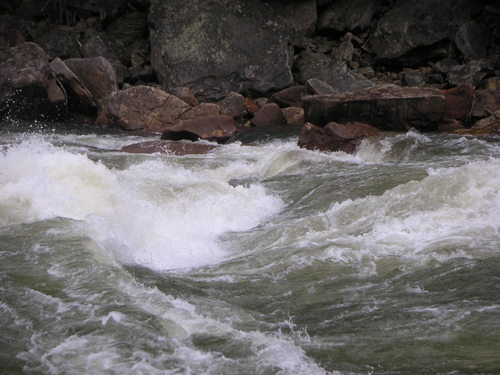 Holes (AKA: Souse Holes, Hydraulics) - A hole is caused by a depression in the river bed like water flowing over a boulder. Water cascades over the boulder (or ledge) forcefully downstream and water from downstream flows back upstream to fill in the depression. We often refer to holes as Smiles or Frowns. If the ends are out flowing downstream (Smile), you can exit the hole on either end. If the ends are facing upstream (Frown), exiting the hole isn't as easy. Upstream ended holes typically have a jet stream underwater that you can catch with your paddle or body to forcefully pull you down and out. A perfectly uniform hole - straight across like one formed by a dam can be very difficult to escape and often requires assistance. Smaller holes are often used like eddies by advanced paddlers. Play boaters (and squirt boaters) love holes as this feature enables the many tricks they like to perform. Here is an example from the Cheat River.
Holes (AKA: Souse Holes, Hydraulics) - A hole is caused by a depression in the river bed like water flowing over a boulder. Water cascades over the boulder (or ledge) forcefully downstream and water from downstream flows back upstream to fill in the depression. We often refer to holes as Smiles or Frowns. If the ends are out flowing downstream (Smile), you can exit the hole on either end. If the ends are facing upstream (Frown), exiting the hole isn't as easy. Upstream ended holes typically have a jet stream underwater that you can catch with your paddle or body to forcefully pull you down and out. A perfectly uniform hole - straight across like one formed by a dam can be very difficult to escape and often requires assistance. Smaller holes are often used like eddies by advanced paddlers. Play boaters (and squirt boaters) love holes as this feature enables the many tricks they like to perform. Here is an example from the Cheat River.
Holes, reversals, souse holes, and stoppers are synonyms. They are formed when water drops over a ledge or boulder and the water downstream of the obstacle rushes back up stream to fill in the void. When you first start paddling, you want to avoid these features. As you gain more skills and become an advanced paddler, you will often use holes as eddy alternatives, for play time, or for quickly crossing a river. Holes come in all shapes and sizes and are sometimes quite challenging to read. River wide holes that are perfectly uniform are typically created by a manmade structure like a dam - these should almost always be avoided as they can be death traps. Here is a video of Swimmers Hole on the Lower Yough: Lower Yough Swimmers Hole
